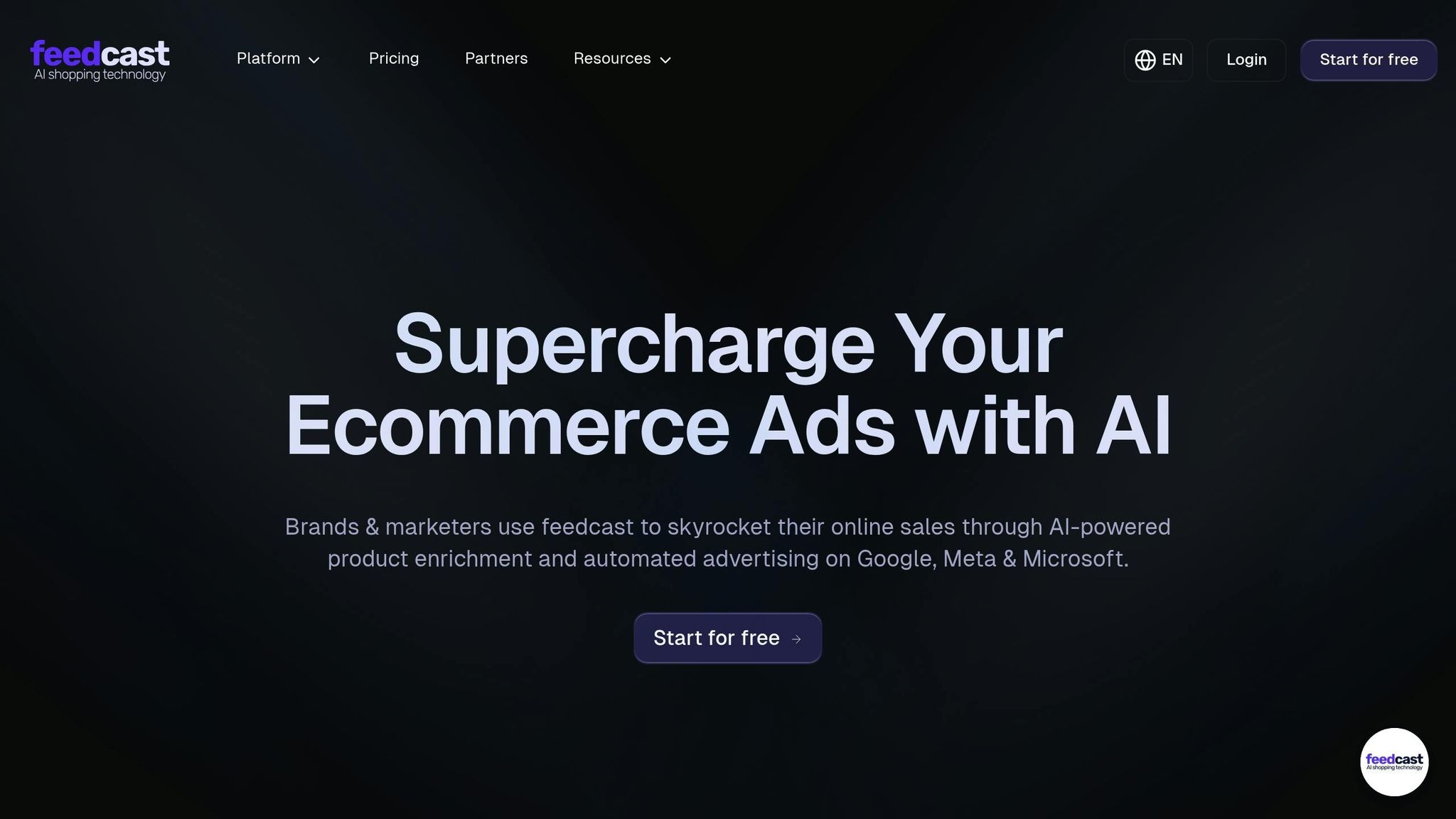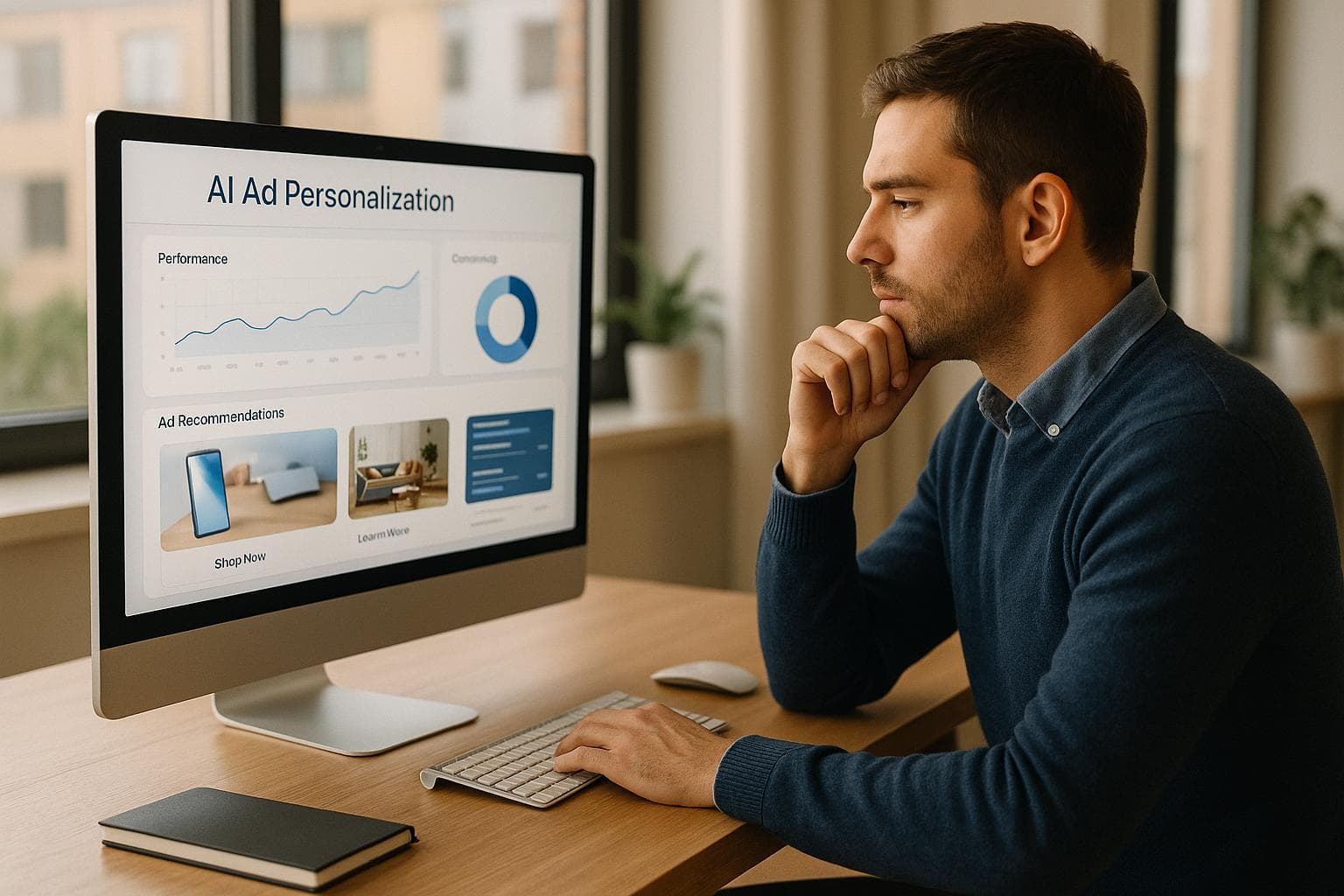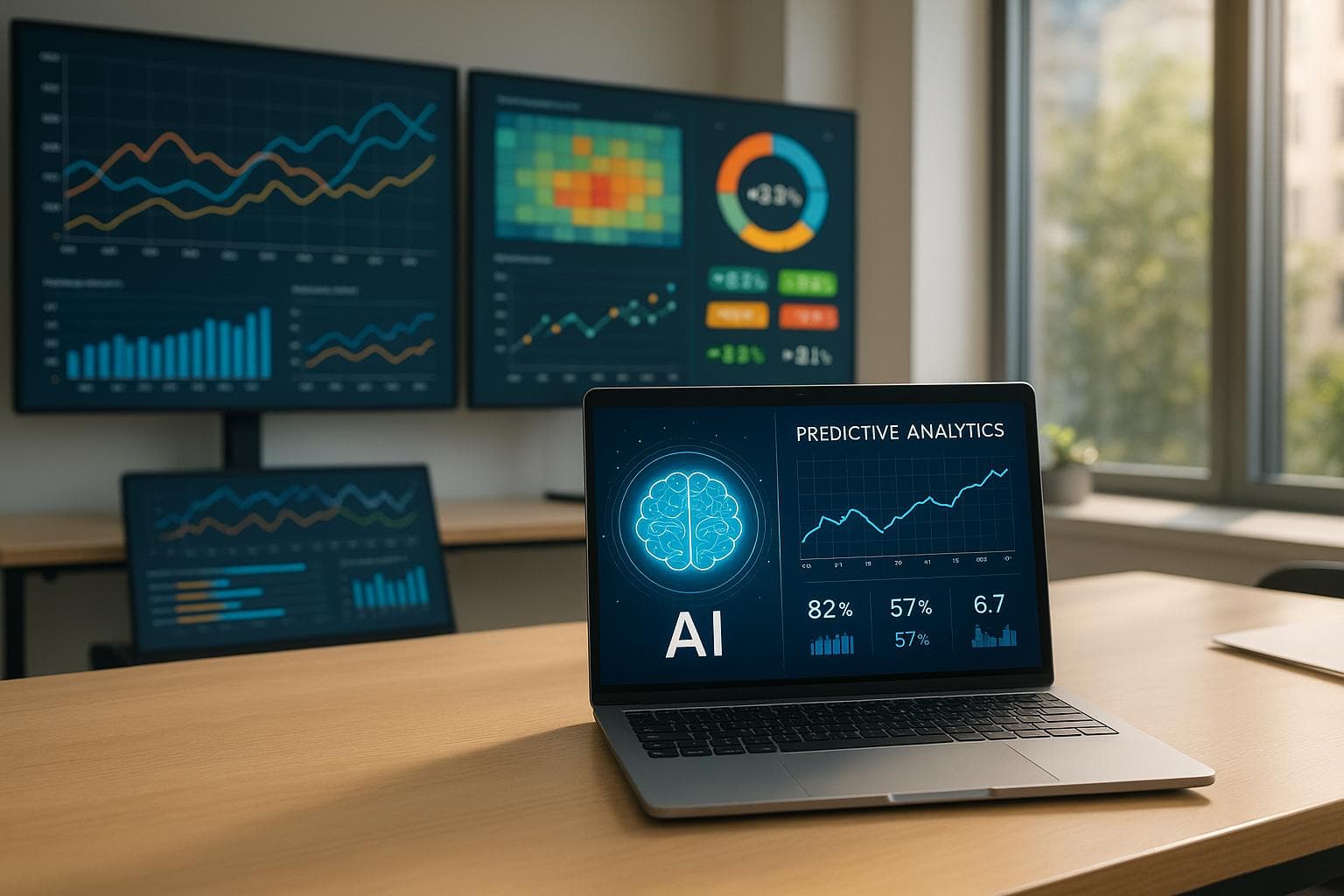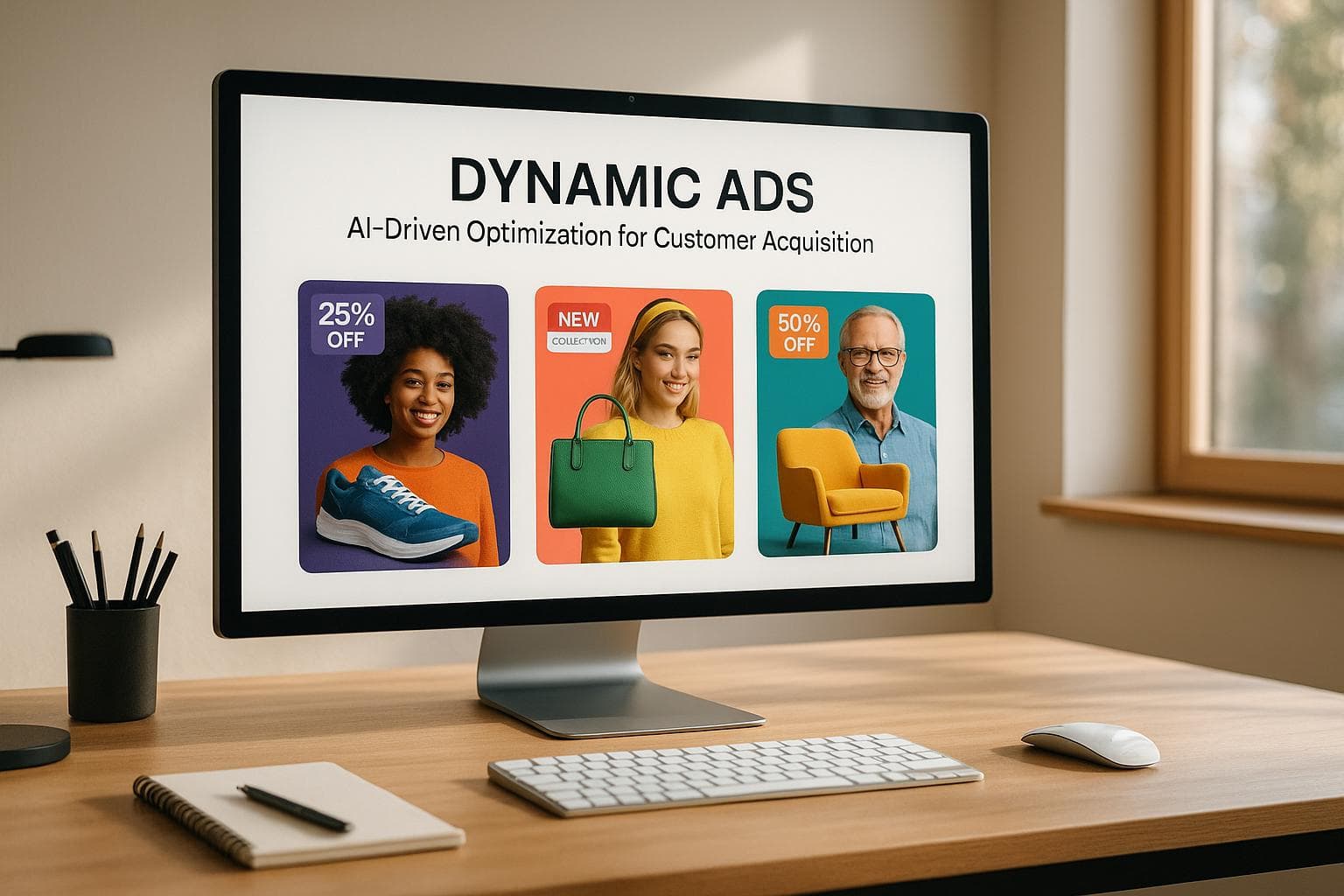Ultimate Guide to AI Ad Personalization
Learn how AI ad personalization enhances customer engagement, boosts revenue, and streamlines campaign management across platforms.
AI ad personalization transforms how businesses connect with customers by using artificial intelligence to analyze real-time data like browsing habits, purchase history, and preferences. This approach creates tailored ads that resonate with individuals, leading to higher engagement, conversions, and revenue growth. Key benefits include:
- Boosted Revenue: Personalized marketing can increase revenue by up to 15% and improve efficiency by 30%.
- Improved Targeting: AI identifies patterns in user behavior to serve relevant ads to the right audience.
- Scalability: AI generates thousands of ad variations, allowing businesses of all sizes to deliver customized experiences.
To implement AI ad personalization, businesses need clean data, unified ad accounts, and integrated product feeds. Tools like Feedcast.ai simplify the process by managing data, automating ad creation, and optimizing campaigns across platforms like Google, Meta, and Microsoft Ads. Tracking metrics like conversion rates, ROAS, and customer retention helps refine strategies for better results.
The future of AI in advertising focuses on first-party data, real-time personalization, and cross-platform integration, addressing challenges like privacy regulations and fragmented data. Businesses adopting AI-driven personalization now are better positioned for success as consumer expectations for tailored experiences grow.
THE SECRET to Personalized Content & Campaigns With AI (STEP-BY-STEP GUIDE)
Main Parts of AI Ad Personalization
To understand how AI ad personalization works, it helps to break it into its three main components. Together, these elements create tailored shopping experiences that lead to better customer engagement and higher conversion rates.
Data Collection and Management
At the heart of AI ad personalization is clean, well-structured data. Without it, even the most advanced algorithms won't deliver relevant ads, leading to missed opportunities and wasted ad budgets[6][9]. High-quality inputs are essential for success.
The most useful data includes browsing history, purchase behaviors, demographic details, and real-time signals like clicks or time spent on specific pages[6][9][2]. This kind of information allows AI to understand not just what customers buy, but how they shop and what grabs their attention.
However, getting this data in order is no small challenge. Many businesses face issues like data silos, inconsistent formats, privacy concerns, and feed errors[6][5]. For instance, customer data might live in one system, product details in another, and advertising metrics somewhere else. This fragmented setup makes it hard for AI to see the full picture.
Platforms like Feedcast.ai tackle these issues by simplifying product feed management. They pull data from e-commerce platforms like Shopify or WooCommerce, enhance product information using AI, and catch feed errors before they disrupt campaigns. This centralized approach ensures the data is clean and ready for AI to work its magic.
But it doesn't stop there. Regular audits and updates are critical because customer preferences and behaviors change over time[6][5]. With unified, accurate data in place, AI can move on to the next step: advanced algorithms.
AI Algorithms and Technologies
Once the data is in good shape, advanced technologies take over to turn it into actionable insights. Using machine learning, predictive analytics, and natural language processing, AI can analyze massive datasets and create highly targeted ad experiences.
Here’s how these technologies work together:
- Machine Learning: Identifies patterns in behavior and demographics to segment audiences effectively.
- Predictive Analytics: Anticipates future actions, like which products a customer is likely to buy, enabling proactive targeting.
- Natural Language Processing (NLP): Interprets customer queries and reviews to refine ad targeting and personalize messaging[6][4][3].
Instead of relying on broad audience categories like "women aged 25-35", AI creates micro-segments based on actual shopping habits. This level of detail allows for hyper-personalized experiences that feel relevant to each customer.
What sets AI apart is its ability to adapt in real-time. Traditional advertising often relies on static audience definitions, but AI continually updates its understanding of each shopper, ensuring ads remain effective and timely[7][8].
Dynamic Ad Creation and Personalization
The final piece of the puzzle is creating personalized ad experiences. AI takes the insights from its algorithms and uses them to customize everything - product recommendations, ad copy, and visuals - based on each shopper’s behavior and preferences[9][1][4].
Some of the main techniques include:
- Collaborative Filtering: Suggests products based on what similar customers have purchased.
- Content-Based Recommendations: Matches product features to individual preferences.
- Dynamic Creative Optimization: Adjusts ad elements like headlines and images in real time to match what resonates with viewers[9][1].
This technology gives businesses an edge by enabling them to create thousands of ad variations in minutes. It also allows for extensive testing, so brands can quickly identify what works best for different audience segments[8].
The results speak for themselves: brands using AI-driven personalization often see conversion rates increase by 10%–30% and higher average order values[9]. Features like personalized product suggestions during checkout or follow-up emails for abandoned carts lead to measurable improvements in sales and retention[9][2].
Tools like Feedcast.ai streamline this process further by generating tailored ad copy for platforms like Google, Meta, and Microsoft Ads. The platform ensures consistency across channels while adapting to each one’s unique audience and requirements.
What makes this approach so powerful is its scalability. Even smaller e-commerce brands can now deliver highly personalized experiences that were once only possible for large enterprises[7][8]. AI handles the complexity of managing thousands of product variations and customer segments, freeing up marketing teams to focus on strategy instead of manual adjustments. This ability to scale across platforms and audiences is what makes dynamic personalization so effective at driving results.
Setting Up AI-Powered Ad Personalization
Using AI to personalize your ad campaigns can completely change the game for your e-commerce business. Instead of running generic ads, you can create tailored experiences that resonate with your audience, boosting both conversions and ROI. But to make it work, you need the right tools and a solid foundation.
What You Need to Get Started
Before diving into AI-powered campaigns, make sure you have these three essentials in place:
- Clean first-party data: This includes accurate customer details, purchase history, browsing behavior, and real-time engagement data. These insights let AI predict preferences and target customers more effectively.
- Unified ad accounts: Managing your ad campaigns across platforms like Google, Meta, and Microsoft Ads from a single place ensures consistent messaging and audience targeting.
- Integrated product feeds: Your product information should be up-to-date and error-free. Detailed attributes help AI create dynamic ads that are more relevant to your audience.
It’s also crucial to prioritize data privacy. Make sure you have explicit user consent and use privacy-compliant tracking solutions like Google Consent Mode v2. Even if your primary audience is in the U.S., complying with regulations like the CCPA builds trust and safeguards your business.
Platforms like Feedcast.ai simplify this process by integrating your data, ad accounts, and product feeds into one streamlined solution.
Using Feedcast.ai for Setup

Feedcast.ai acts as a one-stop platform for managing your ad campaigns. It connects your ad accounts, handles product feeds, and automates data enrichment, making the setup process much smoother.
Here’s how it works:
- The platform imports product data from e-commerce platforms like Shopify, WooCommerce, or PrestaShop, as well as from CSV, XML, or Google Sheets files.
- AI tools enhance your product titles, descriptions, and attributes, helping your ads perform better across different channels.
- Automated error detection ensures your product feeds are free of issues, which is essential for AI algorithms to work effectively.
Setting up campaigns with Feedcast.ai is straightforward:
- Connect your e-commerce store and ad accounts.
- Import and enrich your product feeds.
- Generate personalized ad copy for each advertising channel.
- Configure audience targeting using customer data.
- Launch campaigns across platforms directly from the unified dashboard.
- Monitor and optimize performance with AI-driven insights.
Feedcast.ai even offers a free tier to help you get started. Plus, as a certified Google CSS partner, it can save you 20% on Google Shopping campaigns. With this setup, you’re ready to expand your AI-driven strategy across multiple advertising platforms.
Setting Up Multi-Channel Advertising
Running AI-powered campaigns on multiple platforms like Google, Meta, and Microsoft Ads requires careful coordination to ensure everything works seamlessly.
Start by synchronizing your campaign objectives and creative assets across platforms. While the core message should remain consistent, adapt the presentation to fit each platform’s format and audience. Using unified customer data ensures your audience targeting is cohesive and avoids overlap.
Each platform brings its own AI tools to the table:
- Google’s Performance Max campaigns leverage machine learning across all Google properties.
- Meta’s Advantage+ automates audience targeting and creative testing.
- Microsoft Ads provides automated bidding and audience insights.
Feedcast.ai simplifies this multi-channel approach by managing campaigns for all three platforms from a single dashboard. It ensures your product data and messaging stay consistent while tailoring the details to meet each platform’s specific needs.
The platform also offers a unified analytics dashboard, letting you track performance across channels in one place. You can identify which platforms are delivering the best results and adjust your budget accordingly. By maintaining consistency in your data and messaging while respecting the unique aspects of each platform, you’ll create a seamless experience for your customers, driving higher engagement and better campaign outcomes.
sbb-itb-0bd1697
Tracking and Improving AI Personalization Campaigns
When running AI-powered campaigns, it’s essential to monitor key metrics, analyze results, and fine-tune targeting to get the most out of your investment.
Key Metrics to Measure Success
To make the most of your campaigns, focus on metrics that have a direct impact on revenue. Conversion rate is one of the most critical indicators - it shows the percentage of visitors who make a purchase after seeing personalized ads. In e-commerce, a typical conversion rate ranges between 2–4%, but AI personalization has the potential to push these numbers even higher.
Return on ad spend (ROAS) is another key metric, reflecting how much revenue you generate for every dollar spent on advertising. Aiming for a ROAS of at least 4:1 (earning $4 for every $1 spent) is a solid benchmark. AI-driven campaigns often see ROAS improvements of 15–30% when compared to generic campaigns.
Average order value (AOV) is equally important, as it measures how much customers spend per transaction. AI personalization tools, such as tailored product recommendations and dynamic pricing, can encourage customers to add more to their carts, boosting not just sales but the value of each sale.
For long-term growth, keep an eye on customer lifetime value (CLV) and the customer retention rate. AI excels at identifying your most valuable customers and crafting campaigns to keep them engaged. Even a modest 5% increase in retention can lead to a significant profit boost, making these metrics crucial for sustainable success.
Don’t overlook cart abandonment rates and bounce rates, as they can reveal weak points in your personalization strategy. If users are clicking on your personalized ads but leaving without purchasing, it may signal that your landing page experience needs improvement.
Performance Insights Using Feedcast.ai
Platforms like Feedcast.ai simplify the process of analyzing campaign performance by consolidating data from multiple channels - Google, Meta, Microsoft Ads, and more - into a single dashboard. This unified view allows you to track trends, identify top-performing channels, and make quick adjustments without juggling multiple tools.
With real-time analytics, Feedcast.ai helps you uncover which ad variations convert best, which audience segments are most responsive, and how performance trends shift daily. Custom reporting features let you dive deeper, analyzing performance by product category, customer demographics, or campaign type. This level of detail makes it easier to understand what’s working and where improvements are needed.
Feedcast.ai has already supported over 3,000 e-commerce brands in generating millions of clicks and sales. Its segmentation tools make it easy to pinpoint underperforming creative assets or audience groups, enabling smarter, data-driven decisions. This kind of insight lays the groundwork for ongoing campaign refinement.
Continuous Campaign Improvement
To keep your campaigns effective, continuous optimization is key. A/B testing is a cornerstone of this process. Test personalized versus generic ad copy, experiment with different audience groups, and try out various creative formats - just be sure to test one variable at a time to measure results accurately. For example, HP Tronic achieved a 136% boost in conversions with personalized campaigns, while Yves Rocher saw an 11x increase in conversions using real-time product suggestions.
Fresh creative assets are essential for maintaining engagement. Keep a close watch on click-through rates - if they drop by 20% or more, it’s time for a refresh. AI platforms can streamline this process by generating and testing new ad variations automatically.
AI also plays a vital role in ongoing optimization. Modern platforms can analyze campaign data and recommend adjustments, such as fine-tuning targeting parameters, updating product feeds, or reallocating budgets to better-performing segments. These recommendations often uncover opportunities that could be missed with manual analysis.
Regular reviews are another must. Conduct short-term reviews every 30 days to address immediate issues, quarterly reviews to spot larger trends, and semi-annual reviews to evaluate how your campaigns align with broader business goals.
Be mindful of performance decay. Personalized campaigns often perform well initially but may lose momentum as audiences become accustomed to the messaging. Setting up automated alerts for when key metrics fall below certain thresholds ensures you can act quickly, whether that means updating creative assets or refining targeting.
The most effective campaigns balance AI-driven automation with human oversight. While AI handles real-time adjustments and audience targeting, human marketers bring creativity, strategic vision, and long-term planning to the table. This combination ensures your personalization efforts stay impactful over time.
Future Trends and Challenges in AI Ad Personalization
As AI continues to shape the landscape of e-commerce advertising, new trends and challenges are emerging. These developments are not only transforming how brands connect with their audiences but also presenting hurdles that require innovative solutions.
New Trends in AI-Powered Ads
AI is now enabling real-time personalization, adjusting ads instantly based on live user interactions. This approach prioritizes current behavior over historical data, allowing businesses to deliver offers that align with what customers want at the moment.
With the phaseout of third-party cookies, AI is shifting its focus to first-party data and contextual signals. By relying on direct customer interactions, brands can meet privacy regulations while maintaining effective ad targeting. This shift is encouraging businesses to double down on collecting and analyzing their own data.
Another key trend is multi-touch customer journey mapping. AI can now predict the steps a customer might take, from initial awareness to post-purchase engagement, and deliver tailored messages at each stage.
Additionally, cross-platform integration is becoming essential. AI tools are streamlining campaign management and analytics across platforms like Google, Meta, Microsoft Ads, and soon TikTok. This unified approach ensures consistent messaging and smarter allocation of ad budgets.
While these advancements are exciting, they come with their own set of challenges.
Common Challenges and Solutions
One of the biggest hurdles is data privacy. Regulations like GDPR and CCPA are tightening, making compliance a complex task for businesses. To address this, companies must secure user consent, implement tools like Consent Mode v2, and maintain transparent data practices.
Managing campaigns across several platforms can also be tricky. Fragmented data and inconsistent reporting make it hard to get a clear picture of performance. On top of that, over-segmentation - dividing audiences into too many small groups - can dilute campaign effectiveness by spreading budgets too thin.
To tackle these issues, businesses should consider using unified platforms that centralize data and automate campaign management. Setting clear segmentation rules and investing in strong consent management systems can help ensure compliance and improve campaign results.
How Feedcast.ai Supports Future Readiness
Feedcast.ai offers a solution that bridges these challenges and trends. Its unified multi-channel advertising platform connects all ad accounts into one dashboard, simplifying campaign management across platforms like Google, Meta, Microsoft Ads, and TikTok. This ensures consistent messaging and streamlined operations.
The platform’s AI-driven data enrichment enhances first-party data by improving product titles, descriptions, and other attributes. This boosts ad relevance and visibility, supporting strategies like real-time personalization and contextual targeting - key for navigating a cookieless future.
Feedcast.ai has already made an impact, with over 3,000 e-commerce brands using the platform. Together, they’ve generated millions of clicks and sales. Its unified analytics offer a complete view of customer journeys, while automated optimization tools prevent over-segmentation by focusing on the most engaged audiences.
As a certified Google CSS partner, Feedcast.ai also provides a 20% discount on Google Shopping campaigns, giving brands a competitive edge. With flexible pricing options - from free tiers to enterprise solutions - it’s accessible for businesses of all sizes, helping them prepare for the future of advertising with ease and confidence.
Conclusion
The numbers don’t lie - companies using AI-powered personalization are seeing impressive boosts in conversions. With 66% of customers expecting businesses to understand their unique needs but only 34% feeling those expectations are being met, the gap is clear. Add to that the fact that 63% of people now expect personalized recommendations, and the urgency for businesses to adapt becomes even more apparent[6][7].
AI has made real-time adjustments and seamless cross-platform integration more accessible than ever. Businesses can now analyze customer behavior instantly, tweak campaigns on the fly, and deliver tailored experiences across platforms like Google, Meta, Microsoft Ads, and even newer players like TikTok. What used to require multiple tools and technical expertise is now within reach for businesses of all sizes.
The financial rewards are just as compelling. Research from McKinsey in 2024 shows that personalization can lead to as much as a 15% increase in revenue while improving marketing efficiency by 30%[6]. Platforms like Feedcast.ai demonstrate how far AI personalization has come, with over 3,000 e-commerce brands already leveraging tools that combine data management, AI algorithms, and dynamic creative optimization into streamlined solutions.
As we move forward, the importance of AI-driven personalization will only grow. The phase-out of third-party cookies and stricter privacy regulations make first-party data and AI insights essential for staying competitive. Businesses investing in these technologies today will be better equipped to handle the challenges of tomorrow.
The time to act is now. Start with high-quality data, choose tools that can grow with your business, and focus on refining your approach continuously. By embracing AI-driven personalization, you’re not just meeting customer expectations - you’re setting your brand up for long-term success.
FAQs
How does AI-powered ad personalization address privacy concerns and comply with regulations like GDPR and CCPA?
AI-powered ad personalization takes user privacy seriously by sticking to strict data protection laws like the General Data Protection Regulation (GDPR) and the California Consumer Privacy Act (CCPA). These laws require businesses to be upfront about how they handle personal data, get user consent when needed, and offer clear options for users to control their data preferences.
To meet these standards, platforms often anonymize or aggregate data, reducing the use of any information that could directly identify someone. On top of that, they put strong security measures in place to safeguard data from unauthorized access. These steps help AI-driven advertising strike a careful balance between delivering tailored experiences and respecting privacy while staying within legal boundaries.
What metrics should I track to evaluate the success of AI-powered ad personalization campaigns?
To measure how well AI-driven ad personalization campaigns are performing, it's essential to keep an eye on the key performance metrics across all platforms. Pay attention to figures like engagement rates in real time, conversion rates, return on ad spend (ROAS), and customer acquisition costs (CAC). These numbers will tell you how effectively your campaigns are connecting with your audience and driving results.
A unified dashboard can make this process much easier. With tools that offer custom reports and performance segmentation, you can dig deeper into the data, uncover valuable insights, and adjust your strategy to achieve stronger outcomes.
How can small businesses use AI-powered ad personalization to stay competitive against larger companies?
Small businesses can use AI-driven ad personalization to compete more effectively with larger companies by simplifying their advertising strategies. Tools like Feedcast.ai provide AI-based solutions to manage product data, create tailored ads, and fine-tune campaigns across platforms like Google, Meta, and Microsoft.
By automating tasks such as managing product feeds and refining ad targeting, small businesses can save valuable time, boost ad effectiveness, and increase product exposure. This makes it easier to connect with the right audience and thrive in a competitive market - all without needing a massive advertising budget.
Geoffrey G.










